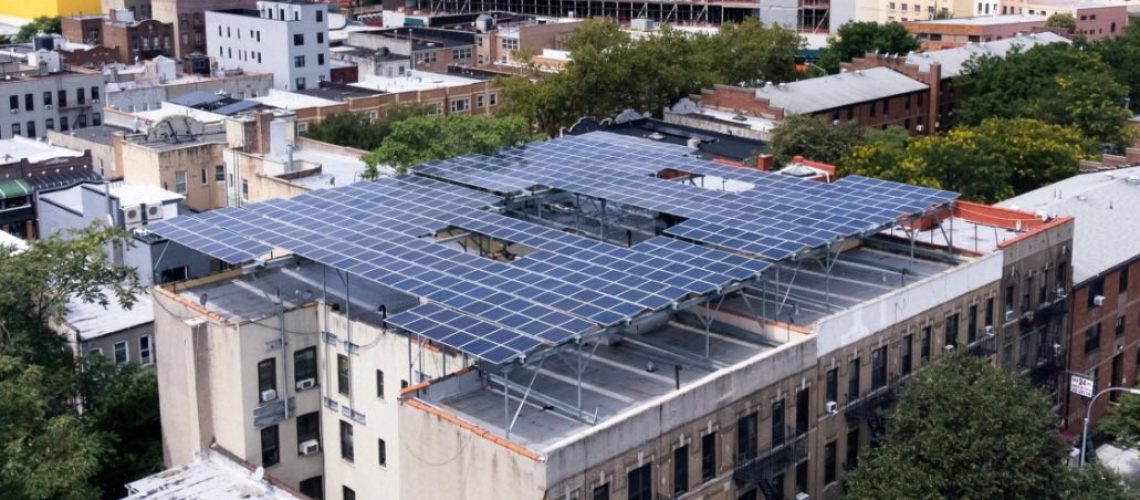The company’s first 46 kW solar canopy was recently deployed in Brownsville, NYC, and features a low 4.5% shading factor.
Urban Energy, a Brooklyn, N.Y.-based distributed energy project developer, recently launched a solar racking business focused on deploying rooftop solar canopies in U.S. metropolitan markets. The new business, called Urban Racking, formed in conjunction with the construction of Urban Energy’s first solar canopy system in Brooklyn, N.Y.
Located in the Brownsville section of Brooklyn, the 46 kW solar canopy was formally approved by utility Con Edison in October. It consists of 118 Canadian Solar bifacial modules (390 watt) and SolarEdge inverters with optimizers, Russell Wilcox, founder and chief executive officer of Urban Energy, told pv magazine USA.
Urban Energy’s solar canopy is more than three times larger than standard rooftop-mounted solar systems whose average output is 14.8 kW, while Urban’s solar canopy is rated at 4.5% shading factor. This is a 16.3% reduction from previous rooftop solar systems whose shading factor is about 20.8% for a comparable rooftop system.
The solar canopy produced 754.1 kWh of output in its first week of operation, while its relative output without shading was about 17.5 kWh per kW, a 17.2% improvement from previous New York City rooftop solar systems, said Wilcox.
According to the company, there are several advantages to Urban Racking systems. They maximize solar potential with bifacial modules, building codes provide no obstruction or fire lane intrusion, and its systems are compatible with energy storage and heat pump systems.
With many urban buildings often having an internal courtyard or rear-facing gap, Urban Racking’s systems are deployed with overlapping support beams that double the amount of modules installed, allowing for 30% more energy production and three times the project value for the building owner when deployed with batteries or heat pumps.
Urban Racking is designing and manufacturing the main structure of its canopy system in-house. The company could procure hardware from a solar tracker manufacturer for future generation systems or design its own tracker, said Wilcox.
Parent company Urban Energy is the first installer and partner of the solar canopy system, while the company will add new installation partners once its third-generation canopy is in production in about a year.
Urban Racking’s second generation canopy system will be installed in the Harlem neighborhood of New York City by the end of 2022. The company plans to deploy its third canopy system in the Bronx during Q3 23, at which point, Wilcox said, the company anticipates closing a $1.5 million pre-seed stage venture funding for Urban Racking.
The company anticipates expanding outside of New York into other markets such as Chicago and the District of Columbia in early 2024, according to Wilcox.
Urban Racking sees a $5 billion marketplace for rooftop solar systems with more than 75,000 buildings in New York providing a 40,000 project funnel for the company in the next few years. Currently the company has three projects in construction and another 51 projects in permitting stages with low to moderate income building owners.
In the racking market, the company competes with Brooklyn Solar Canopy, SunModo and Lumos.
DOE, NREL award recipient
Urban Energy was a finalist in the Department of Energy’s American Made Solar Prize competition in April 2021. To date the company received $150,000 in DOE and NREL funding, as well as $75,000 in DOE vouchers for partnerships and research laboratory opportunities to advance its solar canopy prototype.
Urban Racking was formed by Wilcox earlier this year and hired Mark Preston and Matt Binder as chief executive officer and business development director. Preston is former vice president of engineering for Array Technologies and FTC Solar, while Binder previously held business development roles at Array, Clear Skies Solar and RP Construction Services.
Urban Energy was founded in July 2017 by Russell Wilcox, a NABCEP engineer, and Ilona Wilcox, chief operating officer, with the goal of expanding solar access to low-and-moderate-income multifamily building owners and tenants.



